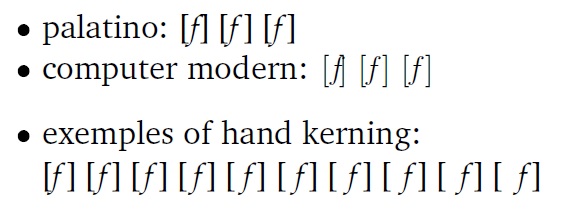# ご質問に対する直接的な回答にはなっていませんが…。
サンプルとして、
bar {\itshape foof foof} baz
という並びを考えてみます。
(“foof” はこの例のためにでっちあげたもので、“foo” の
末尾に “f” を追加してみたものです)
italic correction が入る可能性のある場所を <1> ~ <4> で
表わしてみますと、
bar {\itshape <1>foof<2> <3>foof<4>} baz
となります。
ここで、可能ならば、<1> の次の f について、少し右に移動して
から f を置く、という風に vf で操作出来たらな、と思ったりも
したのですが、<1> と <3> の場合とを区別して、<1> のときだけ
そのような補正をする、というのは難しそうな気がします。
既存の italic correction は文字の右側に追加されるものですけ
れど、<2> と <4> とを識別して、自動で <4> にのみ補正が入ると
いうわけではなくて、<4> の位置に手動で “\/” を追加すること
で補正を実現していたと思います。
文字の左側に italic correction を入れることを考えた場合にも、
<1> と <3> を区別するのは困難だと思われ、そうだとすると <1>
の位置にのみ手作業で何かしら glue や \kern の類いを入れるこ
とで対応するのが現実的なように思えます。
【参考】David Bausum, TeX Reference Manual, Springer, 2002
(Originally, Kluwer, 2002) という TeX のプリミティブのレファ
レンスがありますが、その pp. 28 f. に “/ (italic correction)”
の解説が載っています。
丸々転載するわけにはいきませんので、その一部を転記します。
“Example”、“Produces”、“Comments” の順に叙述されている
のですが、ここでは、“Example” の plain TeX のコードを LaTeX
に書き替えて、そのタイプセット結果の “Produces” は、画像を
下に貼ります。
Example:
\documentclass{article}
\setlength{\parindent}{0pt}
\pagestyle{empty}
\newcommand{\heading}[1]{%
{\fontfamily{bch}\selectfont\leavevmode\llap{\normalfont\textbullet\ }#1}%
}
\begin{document}
\LARGE
\fontfamily{ppl}\selectfont
\heading{palatino:} [{\itshape f}] [{\itshape f\/}] [\/{\itshape f\/}]
\fontfamily{cmr}\selectfont
\heading{computer modern:} [{\itshape f}] [{\itshape f\/}] [\/{\itshape f\/}]
\bigskip
\fontfamily{ppl}\selectfont
% Bausum, TeX Reference Manual, p. 29
\def\R#1{\dimen0=0.05em\multiply\dimen0 by #1\kern\dimen0\relax}
\heading{exemples of hand kerning:}\par
[\R0{\itshape f\/}] [\R1{\itshape f\/}] [\R2{\itshape f\/}] [\R3{\itshape f\/}] [\R4{\itshape f\/}]
[\R5{\itshape f\/}] [\R6{\itshape f\/}] [\R7{\itshape f\/}] [\R8{\itshape f\/}] [\R9{\itshape f\/}]
\end{document}
Comments:
・ The first [f] shows an instance where the f requires an italic
correction. It is added in the second [f].
・ TeX does not provide a pre-character italic correction, and
the third [f] shows `[' does not have an italic correction.
This is not a probrem for CM, but it is for Caslon. It represents
something that will need to be lived with or fixed by hand [f].
・ ... shows several examples of hand kerning. The author's preference
uses \R4.
(原著では例に Caslon が使われていますが、ここでは URWPalladioL
を使っています.Palatino の場合には \R3 くらいがバランスがいい
ように見えます.)
